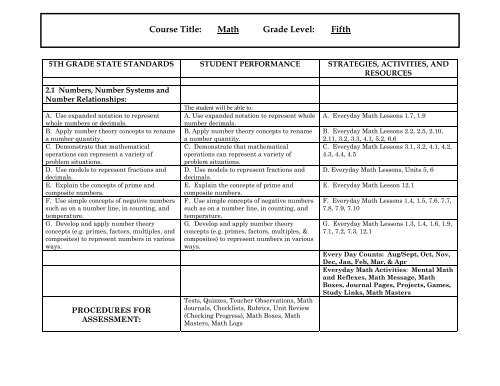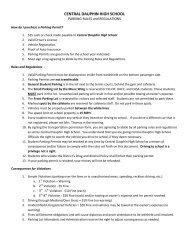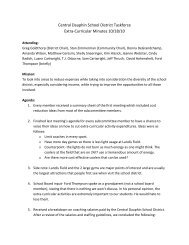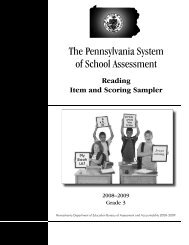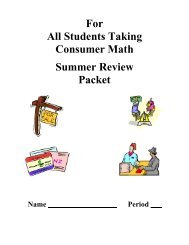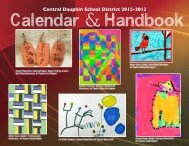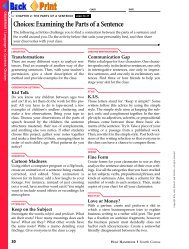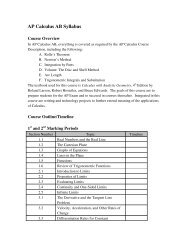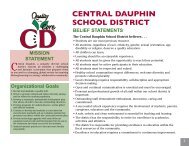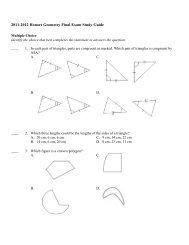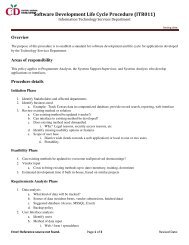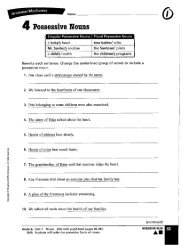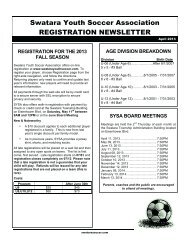Course Title: Math Grade Level: Fifth
Course Title: Math Grade Level: Fifth
Course Title: Math Grade Level: Fifth
Create successful ePaper yourself
Turn your PDF publications into a flip-book with our unique Google optimized e-Paper software.
<strong>Course</strong> <strong>Title</strong>: <strong>Math</strong> <strong>Grade</strong> <strong>Level</strong>: <strong>Fifth</strong><br />
<strong>Math</strong> - <strong>Fifth</strong><br />
Page 1<br />
5TH GRADE STATE STANDARDS STUDENT PERFORMANCE STRATEGIES, ACTIVITIES, AND<br />
RESOURCES<br />
2.1 Numbers, Number Systems and<br />
Number Relationships:<br />
A. Use expanded notation to represent<br />
whole numbers or decimals.<br />
B. Apply number theory concepts to rename<br />
a number quantity.<br />
C. Demonstrate that mathematical<br />
operations can represent a variety of<br />
problem situations.<br />
D. Use models to represent fractions and<br />
decimals.<br />
E. Explain the concepts of prime and<br />
composite numbers.<br />
F. Use simple concepts of negative numbers<br />
such as on a number line, in counting, and<br />
temperature.<br />
G. Develop and apply number theory<br />
concepts (e.g. primes, factors, multiples, and<br />
composites) to represent numbers in various<br />
ways.<br />
PROCEDURES FOR<br />
ASSESSMENT:<br />
The student will be able to:<br />
A. Use expanded notation to represent whole<br />
number decimals.<br />
B. Apply number theory concepts to rename<br />
a number quantity.<br />
C. Demonstrate that mathematical<br />
operations can represent a variety of<br />
problem situations.<br />
D. Use models to represent fractions and<br />
decimals.<br />
E. Explain the concepts of prime and<br />
composite numbers.<br />
F. Use simple concepts of negative numbers<br />
such as on a number line, in counting, and<br />
temperature.<br />
G. Develop and apply number theory<br />
concepts (e.g. primes, factors, multiples, &<br />
composites) to represent numbers in various<br />
ways.<br />
Tests, Quizzes, Teacher Observations, <strong>Math</strong><br />
Journals, Checklists, Rubrics, Unit Review<br />
(Checking Progress), <strong>Math</strong> Boxes, <strong>Math</strong><br />
Masters, <strong>Math</strong> Logs<br />
A. Everyday <strong>Math</strong> Lessons 1.7, 1.9<br />
B. Everyday <strong>Math</strong> Lessons 2.2, 2.5, 2.10,<br />
2.11, 3.2, 3.3, 4.1, 5.2, 6.6<br />
C. Everyday <strong>Math</strong> Lessons 3.1, 3.2, 4.1, 4.2,<br />
4.3, 4.4, 4.5<br />
D. Everyday <strong>Math</strong> Lessons, Units 5, 6<br />
E. Everyday <strong>Math</strong> Lesson 12.1<br />
F. Everyday <strong>Math</strong> Lessons 1.4, 1.5, 7.6, 7.7,<br />
7.8, 7.9, 7.10<br />
G. Everyday <strong>Math</strong> Lessons 1.3, 1.4, 1.6, 1.9,<br />
7.1, 7.2, 7.3, 12.1<br />
Every Day Counts: Aug/Sept, Oct, Nov,<br />
Dec, Jan, Feb, Mar, & Apr<br />
Everyday <strong>Math</strong> Activities: Mental <strong>Math</strong><br />
and Reflexes, <strong>Math</strong> Message, <strong>Math</strong><br />
Boxes, Journal Pages, Projects, Games,<br />
Study Links, <strong>Math</strong> Masters
<strong>Math</strong> - <strong>Fifth</strong><br />
Page 2<br />
5TH GRADE STATE STANDARDS STUDENT PERFORMANCE STRATEGIES, ACTIVITIES, AND<br />
RESOURCES<br />
2.2 Computation and Estimation:<br />
A. Create and solve word problems<br />
involving addition, subtraction,<br />
multiplication and division of whole<br />
numbers.<br />
B. Develop and apply algorithms to solve<br />
word problems that involve addition,<br />
subtraction, and/or multiplication with<br />
decimals with and without regrouping,<br />
fractions and mixed numbers, that include<br />
like and unlike denominators.<br />
C. Demonstrate the ability to round<br />
numbers.<br />
D. Determine through estimations the<br />
reasonableness of answers to problems<br />
involving addition, subtraction,<br />
multiplication and division of whole<br />
numbers.<br />
E. Demonstrate skills for using fraction<br />
calculators to verify conjectures, confirm<br />
computations, and explore complex problems<br />
solving situations.<br />
F. Apply estimation strategies to a variety<br />
of problems including time and money.<br />
G. Explain multiplication and division<br />
algorithms.<br />
The student will be able to:<br />
A. Create and solve word problems<br />
involving addition, subtraction,<br />
multiplication and division of whole<br />
numbers.<br />
B. Develop and apply algorithms to solve<br />
word problems that involve addition,<br />
subtraction, and/or multiplication with<br />
decimals with and without regrouping,<br />
fractions and mixed numbers, that include<br />
like and unlike denominators.<br />
C. Demonstrate the ability to round<br />
numbers.<br />
D. Determine through estimations the<br />
reasonableness of answers to problems<br />
involving addition, subtraction,<br />
multiplication and division of whole<br />
numbers.<br />
E. Demonstrate skills for using fraction<br />
calculators to verify conjectures, confirm<br />
computations, and explore complex problems<br />
solving situations.<br />
F. Apply estimation strategies to a variety<br />
of problems including time and money.<br />
G. Explain multiplication and division<br />
algorithms.<br />
A. Everyday <strong>Math</strong> Lessons 2.4, 4.1, 4.2, 4.4,<br />
4.5<br />
B. Everyday <strong>Math</strong> Lessons 2.2, 2.3, 4.4, 4.5,<br />
4.6, 5.3, 6.8, 6.9, 6.10, 8.1, 8.2, 8.3, 8.4, 8.8,<br />
8.12<br />
C. Everyday <strong>Math</strong> Lesson 2.7<br />
D. Everyday <strong>Math</strong> Lessons 4.4, 4.5<br />
E. Everyday <strong>Math</strong> Lesson 8.4<br />
F. Everyday <strong>Math</strong> Lesson 2.10<br />
G. Everyday <strong>Math</strong> Lessons 1.2, 1.3, 1.4, 1.5,<br />
1.6, 1.7, 1.8, 1.9, 8.5, 8.6, 8.7, 8.8, 8.9
H. Select a method for computation and<br />
explain why it is appropriate.<br />
PROCEDURES FOR<br />
ASSESSMENT:<br />
H. Select a method for computation and<br />
explain why it is appropriate.<br />
Tests, Quizzes, Teacher Observations, <strong>Math</strong><br />
Journals, Checklists, Rubrics, Unit Review<br />
(Checking Progress), <strong>Math</strong> Boxes, <strong>Math</strong><br />
Masters, <strong>Math</strong> Logs<br />
H. Everyday <strong>Math</strong> Lessons 7.3, 10.3<br />
<strong>Math</strong> - <strong>Fifth</strong><br />
Page 3<br />
Every Day Counts: Aug/Sept, Nov, Dec,<br />
Jan, Mar, Apr, May/June<br />
Everyday <strong>Math</strong> Activities: Mental <strong>Math</strong><br />
and Reflexes, <strong>Math</strong> Message, <strong>Math</strong><br />
Boxes, Journal Pages, Projects, Games,<br />
Study Links, <strong>Math</strong> Masters
<strong>Math</strong> - <strong>Fifth</strong><br />
Page 4<br />
5TH GRADE STATE STANDARDS STUDENT PERFORMANCE STRATEGIES, ACTIVITIES, AND<br />
RESOURCES<br />
2.3 Measurement and Estimation:<br />
The student will be able to:<br />
A. Select and use appropriate instruments A. Select and use appropriate instruments A. Everyday <strong>Math</strong> Lessons 11.4<br />
and units for measuring quantities such as<br />
perimeter, volume, area, weight, time and<br />
temperature.<br />
and units for measuring quantities such as<br />
perimeter, volume, area, weight, time and<br />
temperature.<br />
B. Select and use standard tools to measure B. Select and use standard tools to measure B. Everyday <strong>Math</strong> Lesson 6.2, 10.8<br />
the size of figures with specified accuracy,<br />
including length, width, perimeter, and area.<br />
the size of figures with specified accuracy,<br />
including length, width, perimeter, and area.<br />
C. Estimate, refine, and verify specified C. Estimate, refine, and verify specified C. Everyday <strong>Math</strong> Lesson 9.7<br />
measurements of objects.<br />
measurements of objects.<br />
D. Convert linear measurements within the D. Convert linear measurements within the D. Everyday <strong>Math</strong> Lesson 6.2<br />
same system.<br />
same system(e.g. US customary and metric<br />
units).<br />
E. Add and subtract measurements. E. Add and subtract measurements. E. Everyday <strong>Math</strong> Lesson 4.3<br />
PROCEDURES FOR<br />
ASSESSMENT:<br />
Tests, Quizzes, Teacher Observations, <strong>Math</strong><br />
Journals, Checklists, Rubrics, Unit Review<br />
(Checking Progress), <strong>Math</strong> Boxes, <strong>Math</strong><br />
Masters, <strong>Math</strong> Logs<br />
Every Day Counts: Jan & Mar<br />
Everyday <strong>Math</strong> Activities: Mental <strong>Math</strong><br />
and Reflexes, <strong>Math</strong> Message, <strong>Math</strong><br />
Boxes, Journal Pages, Projects, Games,<br />
Study Links, <strong>Math</strong> Masters
<strong>Math</strong> - <strong>Fifth</strong><br />
Page 5<br />
5TH GRADE STATE STANDARDS STUDENT PERFORMANCE STRATEGIES, ACTIVITIES, AND<br />
RESOURCES<br />
2.4 <strong>Math</strong>ematical Reasoning and<br />
Connections:<br />
A. Compare quantities and magnitudes of<br />
numbers.<br />
B. Use models, number facts, properties and<br />
relationships to check and verify predictions<br />
and explain reasoning.<br />
C. Draw inductive and deductive<br />
conclusions within mathematical contexts.<br />
D. Distinguish between relevant and<br />
irrelevant information in a mathematical<br />
problem.<br />
E. Interpret statements made with precise<br />
language of logic (i.e. all, every, none, some,<br />
or many).<br />
F. Use statistics to quantify issues in social<br />
studies.<br />
PROCEDURES FOR<br />
ASSESSMENT:<br />
The student will be able to:<br />
A. Compare quantities and magnitudes of<br />
numbers.<br />
B. Use models, number facts, properties and<br />
relationships to check and verify predictions<br />
and explain reasoning.<br />
C. Draw inductive and deductive<br />
conclusions within mathematical contexts.<br />
D. Distinguish between relevant and<br />
irrelevant information in a mathematical<br />
problem.<br />
E. Interpret statements made with precise<br />
language of logic (i.e. all, every, none, some,<br />
or many).<br />
F. Use statistics to quantify issues in any<br />
content.<br />
Tests, Quizzes, Teacher Observations, <strong>Math</strong><br />
Journals, Checklists, Rubrics, Unit Review<br />
(Checking Progress), <strong>Math</strong> Boxes, <strong>Math</strong><br />
Masters, <strong>Math</strong> Logs<br />
A. Everyday <strong>Math</strong> Lessons 2.8, 2.9, 7.6<br />
B. Everyday <strong>Math</strong> Lessona 1.2, 1.7<br />
C. Everyday <strong>Math</strong> Lesson 11.2<br />
D. Everyday <strong>Math</strong> Lessons 7.3<br />
E. Everyday <strong>Math</strong> Lesson 11.2<br />
F. Everyday <strong>Math</strong> Lesson 5.12<br />
Every Day Counts: Aug/Sept, Oct, Nov,<br />
Dec, Jan & Feb<br />
Everyday <strong>Math</strong> Activities: Mental <strong>Math</strong><br />
and Reflexes, <strong>Math</strong> Message, <strong>Math</strong><br />
Boxes, Journal Pages, Projects, Games,<br />
Study Links, <strong>Math</strong> Masters
<strong>Math</strong> - <strong>Fifth</strong><br />
Page 6<br />
5TH GRADE STATE STANDARDS STUDENT PERFORMANCE STRATEGIES, ACTIVITIES, AND<br />
RESOURCES<br />
2.5 <strong>Math</strong>ematical Problem Solving<br />
and Communication:<br />
A. Develop a plan to analyze a problem,<br />
identify the information needed to solve the<br />
problem, carry out the plan, check whether<br />
an answer makes sense and explain how the<br />
problem was solved.<br />
B. Use appropriate mathematical terms,<br />
vocabulary, language symbols and graphs to<br />
clearly and logically explain solutions to<br />
problems.<br />
C. Show ideas in a variety of ways,<br />
including words, numbers, symbols, pictures,<br />
charts, graphs, tables, diagrams and models.<br />
D. Connect, extend, and generalize problem<br />
solutions to other concepts, problems and<br />
circumstances in mathematics.<br />
E. Select, use, and justify the methods,<br />
materials and strategies used to solve<br />
problems.<br />
F. Use appropriate problem solving<br />
strategies such as solving a simpler problem<br />
or drawing a picture or diagram.<br />
PROCEDURES FOR<br />
ASSESSMENT:<br />
The student will be able to:<br />
A. Develop a plan to analyze a problem,<br />
identify the information needed to solve the<br />
problem, carry out the plan, check whether<br />
an answer makes sense and explain how the<br />
problem was solved.<br />
B. Use appropriate mathematical terms,<br />
vocabulary, language symbols and graphs to<br />
clearly and logically explain solutions to<br />
problems.<br />
C. Show ideas in a variety of ways,<br />
including words, numbers, symbols, pictures,<br />
charts, graphs, tables, diagrams and models.<br />
D. Connect, extend, and generalize problem<br />
solutions to other concepts, problems and<br />
circumstances in mathematics.<br />
E. Select, use, and justify the methods,<br />
materials and strategies used to solve<br />
problems.<br />
F. Use appropriate problem solving<br />
strategies such as solving a simpler problem<br />
or drawing a picture or diagram.<br />
Tests, Quizzes, Teacher Observations, <strong>Math</strong><br />
Journals, Checklists, Rubrics, Unit Review<br />
(Checking Progress), <strong>Math</strong> Boxes, <strong>Math</strong><br />
Masters, <strong>Math</strong> Logs<br />
A. Everyday <strong>Math</strong> Lesson 4.5<br />
B. Everyday <strong>Math</strong> Lessons - All Units<br />
C. Everyday <strong>Math</strong> Lessons 1.2, 1.7, 10.4,<br />
10.5, 10.6, 10.7, 12.4<br />
D. Everyday <strong>Math</strong> Lessons - All Units<br />
E. Everyday <strong>Math</strong> Lessons - All Units<br />
F. Everyday <strong>Math</strong> Lesson 7.3<br />
Every Day Counts: Aug/Sept, Oct, Nov,<br />
Dec, and May/June<br />
Everyday <strong>Math</strong> Activities: Mental <strong>Math</strong><br />
and Reflexes, <strong>Math</strong> Message, <strong>Math</strong><br />
Boxes, Journal Pages, Projects, Games,<br />
Study Links, <strong>Math</strong> Masters
<strong>Math</strong> - <strong>Fifth</strong><br />
Page 7<br />
5TH GRADE STATE STANDARDS STUDENT PERFORMANCE STRATEGIES, ACTIVITIES, AND<br />
RESOURCES<br />
2.6 Statistics and Data Analysis:<br />
The student will be able to:<br />
A. Organize and display data using pictures,<br />
tallies, tables, charts, bar graphs, and circle<br />
A. Organize and display data using pictures,<br />
tallies, tables, charts, bar graphs, and circle<br />
A. Everyday <strong>Math</strong> Lessons 5.10, 5.11, 6.1,<br />
6.4, 6.5, 6.6, 12.7<br />
graphs.<br />
graphs.<br />
B. Describe data sets using mean, median, B. Describe data sets using mean, median, B. Everyday <strong>Math</strong> Lesson 2.5<br />
mode and range.<br />
mode and range.<br />
C. Sort data using Venn diagrams. C. Sort data using comparison diagrams. C. Everyday <strong>Math</strong> Lesson 11.2<br />
D. Predict the likely number of times a<br />
condition will occur based on the analyzed<br />
data.<br />
E. Construct and defend simple conclusions<br />
based on data.<br />
PROCEDURES FOR<br />
ASSESSMENT:<br />
D. Predict the likely number of times a<br />
condition will occur based on the analyzed<br />
data.<br />
E. Construct and defend simple conclusions<br />
based on data.<br />
Tests, Quizzes, Teacher Observations, <strong>Math</strong><br />
Journals, Checklists, Rubrics, Unit Review<br />
(Checking Progress), <strong>Math</strong> Boxes, <strong>Math</strong><br />
Masters, <strong>Math</strong> Logs<br />
D. Everyday <strong>Math</strong> Lesson 8.11<br />
E. Everyday <strong>Math</strong> Lesson 8.11<br />
Every Day Counts: Oct, Nov, Dec, Jan,<br />
Feb, and Apr<br />
Everyday <strong>Math</strong> Activities: Mental <strong>Math</strong><br />
and Reflexes, <strong>Math</strong> Message, <strong>Math</strong><br />
Boxes, Journal Pages, Projects, Games,<br />
Study Links, <strong>Math</strong> Masters
<strong>Math</strong> - <strong>Fifth</strong><br />
Page 8<br />
5TH GRADE STATE STANDARDS STUDENT PERFORMANCE STRATEGIES, ACTIVITIES, AND<br />
RESOURCES<br />
2.7 Probability and Predictions:<br />
A. Perform simulations with concrete<br />
devices (dice, spinner, etc.) to predict the<br />
chance of an event occurring.<br />
B. Determine the fairness of the design of a<br />
spinner.<br />
C. Express probabilities as fractions and<br />
decimals.<br />
D. Compare predictions based on theoretical<br />
probability and experimental results.<br />
E. Calculate the probability of a simple<br />
event.<br />
F. Determine patterns generated as a result<br />
of an experiment<br />
G. Determine the probability of an event<br />
involving "and", "or" or "not".<br />
H. Predict and determine why some<br />
outcomes are certain, more likely, less likely,<br />
equally likely or impossible.<br />
I. Find all possible combinations and<br />
arrangements involving a limited number of<br />
variables.<br />
J. Make a tree diagram and list the<br />
elements in the sample space.<br />
PROCEDURES FOR<br />
ASSESSMENT:<br />
The student will be able to:<br />
A. Perform simulations with concrete devices<br />
(dice, spinner, etc.) to predict the chance of<br />
an event occurring.<br />
B. Determine the fairness of the design of a<br />
spinner.<br />
C. Express probabilities as fractions and<br />
decimals.<br />
D. Compare predictions based on theoretical<br />
probability and experimental results.<br />
E. Calculate the probability of a simple<br />
event.<br />
F. Determine patterns generated as a result<br />
of an experiment.<br />
G. Determine the probability of an event<br />
involving "and", "or" or "not".<br />
H. Predict and determine why some<br />
outcomes are certain, more likely, less likely,<br />
equally likely or impossible.<br />
I. Find all possible combinations and<br />
arrangements involving a limited number of<br />
variables.<br />
J. Make a tree diagram and list the elements<br />
in the sample space.<br />
Tests, Quizzes, Teacher Observations, <strong>Math</strong><br />
Journals, Checklists, Rubrics, Unit Review<br />
(Checking Progress), <strong>Math</strong> Boxes, <strong>Math</strong><br />
Masters, <strong>Math</strong> Logs<br />
A. Everyday <strong>Math</strong> Lesson 2.6<br />
B. Everyday <strong>Math</strong> Lesson 6.5<br />
C. Everyday <strong>Math</strong> Lesson 12.3<br />
D. Everyday <strong>Math</strong> Lesson 2.6<br />
E. Everyday <strong>Math</strong> Lesson 12.5<br />
F. Everyday <strong>Math</strong> Lessons 5.10, 5.11, 10.4<br />
G. Everyday <strong>Math</strong> Lesson 12.2<br />
H. Everyday <strong>Math</strong> Lesson 12.2<br />
I. Everyday <strong>Math</strong> Lesson 12.2<br />
J. Everyday <strong>Math</strong> Lesson 12.2<br />
Every Day Counts: Aug/Sept, Oct, Nov,<br />
Dec, Jan, Feb, Mar, Apr, and May/June<br />
Everyday <strong>Math</strong> Activities: Mental <strong>Math</strong><br />
and Reflexes, <strong>Math</strong> Message, <strong>Math</strong><br />
Boxes, Journal Pages, Projects, Games,<br />
Study Links, <strong>Math</strong> Masters
<strong>Math</strong> - <strong>Fifth</strong><br />
Page 9<br />
5TH GRADE STATE STANDARDS STUDENT PERFORMANCE STRATEGIES, ACTIVITIES, AND<br />
RESOURCES<br />
2.8 Algebra and Functions:<br />
A. Recognize, reproduce, extend, create and<br />
describe patterns, sequences and<br />
relationships verbally, numerically,<br />
symbolically and graphically, using a variety<br />
of materials.<br />
B. Connect patterns to geometric relations<br />
and basic number skills.<br />
C. Form rules based on patterns (e.g., an<br />
equation that relates pairs in a sequence).<br />
D. Use concrete objects and combinations of<br />
symbols and numbers to create expressions<br />
that model mathematical situations.<br />
E. Explain the use of combinations of<br />
symbols and numbers in expressions,<br />
equations, and inequalities.<br />
F. Describe a realistic situation using<br />
information given in equations, inequalities,<br />
fables or graphs.<br />
G. Select and use appropriate strategies,<br />
including concrete materials, to solve<br />
number sentences and explain the method of<br />
solution.<br />
The student will be able to:<br />
A. Recognize, reproduce, extend, create and<br />
describe patterns, sequences and<br />
relationships verbally, numerically,<br />
symbolically and graphically, using a variety<br />
of materials.<br />
B. Connect patterns to geometric relations<br />
and basic number skills.<br />
C. Form rules based on patterns (e.g., an<br />
equation that relates pairs in a sequence).<br />
D. Use concrete objects and combinations of<br />
symbols and numbers to create expressions<br />
that model mathematical situations.<br />
E. Explain the use of combinations of<br />
symbols and numbers in expressions,<br />
equations, and inequalities.<br />
F. Describe a realistic situation using<br />
information given in equations, inequalities,<br />
fables or graphs.<br />
G. Select and use appropriate strategies,<br />
including concrete materials, to solve<br />
number sentences and explain the method of<br />
solution.<br />
A. Everyday <strong>Math</strong> Lessons 1.7, 10.4<br />
B. Everyday <strong>Math</strong> Lessons 3.3, 6.8<br />
C. Everyday <strong>Math</strong> Lessons 1.5, 1.7, 7.5, 10.5<br />
D. Everyday <strong>Math</strong> Lessons 10.1, 10.2, 10.5<br />
E. Everyday <strong>Math</strong> Lesson 1.8<br />
F. Everyday <strong>Math</strong> Lessons 10.3, 10.4, 10.5,<br />
10.6, 10.7<br />
G. Everyday <strong>Math</strong> Lessons 7.4, 7.5, Handson<br />
Equations
H. Locate and identify points on a coordinate<br />
system.<br />
I. Generate functions from tables of data and<br />
relate data to corresponding graphs and<br />
functions.<br />
PROCEDURES FOR<br />
ASSESSMENT:<br />
H. Locate and identify points on a coordinate<br />
system.<br />
I. Generate functions from tables of data and<br />
relate data to corresponding graphs and<br />
functions.<br />
Tests, Quizzes, Teacher Observations, <strong>Math</strong><br />
Journals, Checklists, Rubrics, Unit Review<br />
(Checking Progress), <strong>Math</strong> Boxes, <strong>Math</strong><br />
Masters, <strong>Math</strong> Logs<br />
<strong>Math</strong> - <strong>Fifth</strong><br />
Page 10<br />
H. Everyday <strong>Math</strong> Lessons 9.1, 9.2, 9.3<br />
I. Everyday <strong>Math</strong> Lessons 10.4, 10.5, 10.6<br />
Every Day Counts: Aug/Sept, Oct, Nov,<br />
Dec, Jan, Feb, Mar, and Apr<br />
Everyday <strong>Math</strong> Activities: Mental <strong>Math</strong><br />
and Reflexes, <strong>Math</strong> Message, <strong>Math</strong><br />
Boxes, Journal Pages, Projects, Games,<br />
Study Links, <strong>Math</strong> Masters
<strong>Math</strong> - <strong>Fifth</strong><br />
Page 11<br />
5TH GRADE STATE STANDARDS STUDENT PERFORMANCE STRATEGIES, ACTIVITIES, AND<br />
RESOURCES<br />
2.9 Geometry:<br />
A. Give formal definitions of geometric<br />
figures.<br />
B. Classify and compare triangles and<br />
quadrilaterals according to sides or angles.<br />
The student will be able to:<br />
A. Give formal definitions of geometric<br />
figures.<br />
B. Classify and compare triangles and<br />
quadrilaterals according to sides or angles.<br />
A. Everyday <strong>Math</strong> Lessons 1.1, 11.1, 11.2<br />
B. Everyday <strong>Math</strong> Lessons 3.3, 3.4, 3.5, 3.6,<br />
3.8, 3.9<br />
C. Identify and measure circles, their C. Identify and measure circles, their C. Everyday <strong>Math</strong> Lesson 10.8<br />
diameters and radii.<br />
diameters and radii.<br />
D. Describe in words how geometric shapes D. Describe in words how geometric shapes D. Everyday <strong>Math</strong> Lesson 3.5<br />
are constructed.<br />
are constructed.<br />
E. Construct two and three dimensional<br />
shapes and figures using manipulatives,<br />
geoboards and computer software.<br />
E. Construct two and three dimensional<br />
shapes and figures using manipulatives,<br />
geoboards.<br />
E. Everyday <strong>Math</strong> Lesson 11.1, Geoboards,<br />
pattern blocks, color tiles, dot paper, graph<br />
paper<br />
F. Find familiar solids in the environment F. Find familiar solids in the environment F. Everyday <strong>Math</strong> Lesson 11.1<br />
and describe them.<br />
and describe them.<br />
G. Create an original tesselation. G. Create an original tesselation. G. Everyday <strong>Math</strong> Lesson 3.8, Pattern<br />
Blocks<br />
H. Describe the relationship between the<br />
perimeter and area of triangles,<br />
H. Describe the relationship between the<br />
perimeter and area of triangles,<br />
H. Everyday <strong>Math</strong> Lessons 9.4, 9.5, 9.6, 10.8,<br />
10.9, 11.1, 11.4<br />
quadrilaterals and circles.<br />
quadrilaterals and circles.<br />
I. Represent and use the concepts of line,<br />
point, and plane.<br />
I. Represent and use the concepts of line,<br />
point, and plane.<br />
I. Everyday <strong>Math</strong> Lesson 3.5<br />
J. Define the basic properties of squares,<br />
pyramids, parallelograms, quadrilaterals,<br />
trapezoids, polygons, rectangles, rhombi,<br />
circles, triangles, cubes, prisms, spheres, and<br />
cylinders.<br />
K. Analyze simple transformations of<br />
geometric figures and rotations of line<br />
segments.<br />
J. Define the basic properties of squares,<br />
pyramids, parallelograms, quadrilaterals,<br />
trapezoids, polygons, rectangles, rhombi,<br />
circles, triangles, cubes, prisms, spheres, and<br />
cylinders.<br />
K. Analyze simple transformations of<br />
geometric figures and rotations of line<br />
segments.<br />
J. Everyday <strong>Math</strong> Lessons 3.7, 9.4, 9.5, 9.6,<br />
11.7<br />
K. Everyday <strong>Math</strong> Lesson 3.4
L. Identify properties of geometric figures<br />
(i.e. parallel, perpendicular, similar,<br />
congruent, symmetrical).<br />
PROCEDURES FOR<br />
ASSESSMENT:<br />
L. Identify properties of geometric figures<br />
(i.e. parallel, perpendicular, similar,<br />
congruent, symmetrical).<br />
Tests, Quizzes, Teacher Observations, <strong>Math</strong><br />
Journals, Checklists, Rubrics, Unit Review<br />
(Checking Progress), <strong>Math</strong> Boxes, <strong>Math</strong><br />
Masters, <strong>Math</strong> Logs<br />
L. Everyday <strong>Math</strong> Lesson 3.6<br />
<strong>Math</strong> - <strong>Fifth</strong><br />
Page 12<br />
Every Day Counts: Nov, Jan, Feb, Mar,<br />
Apr, and May/June<br />
Everyday <strong>Math</strong> Activities: Mental <strong>Math</strong><br />
and Reflexes, <strong>Math</strong> Message, <strong>Math</strong><br />
Boxes, Journal Pages, Projects, Games,<br />
Study Links, <strong>Math</strong> Masters
<strong>Math</strong> - <strong>Fifth</strong><br />
Page 13<br />
5TH GRADE STATE STANDARDS STUDENT PERFORMANCE STRATEGIES, ACTIVITIES, AND<br />
RESOURCES<br />
2.10 Trigonometry:<br />
A. Identify and compare parts of right<br />
triangle including right angles, acute angles,<br />
hypotenuse, and legs.<br />
The student will be able to:<br />
A. Identify and compare parts of right<br />
triangle including right angles, acute angles,<br />
hypotenuse, and legs.<br />
A. Everyday <strong>Math</strong> Lesson 4.6 (Include<br />
Teacher-Created Materials for Hypotenuse,<br />
Legs)<br />
B. Create right triangles on a geoboard. B. Create right triangles using a variety of<br />
materials.<br />
B. Everyday <strong>Math</strong> Lesson 4.6, Geoboards<br />
Every Day Counts: Feb, Mar, and Apr<br />
PROCEDURES FOR<br />
ASSESSMENT:<br />
Tests, Quizzes, Teacher Observations, <strong>Math</strong><br />
Journals, Checklists, Rubrics, Unit Review<br />
(Checking Progress), <strong>Math</strong> Boxes, <strong>Math</strong><br />
Masters, <strong>Math</strong> Logs<br />
Everyday <strong>Math</strong> Activities: Mental <strong>Math</strong><br />
and Reflexes, <strong>Math</strong> Message, <strong>Math</strong><br />
Boxes, Journal Pages, Projects, Games,<br />
Study Links, <strong>Math</strong> Masters
<strong>Math</strong> - <strong>Fifth</strong><br />
Page 14<br />
5TH GRADE STATE STANDARDS STUDENT PERFORMANCE STRATEGIES, ACTIVITIES, AND<br />
RESOURCES<br />
2.11 Concepts of Calculus:<br />
The student will be able to:<br />
A. Make comparisons of numbers such as<br />
more, less, same, least, most, greater than<br />
A. Make comparisons of numbers such as<br />
more, less, same, least, most, greater than<br />
A. Everyday <strong>Math</strong> Lessons 5.3, 8.1, 8.2, 8.12,<br />
12.8<br />
and less than.<br />
and less than.<br />
B. Identify least and greatest values B. Identify least and greatest values B. Everyday <strong>Math</strong> Lessons 5.9, 5.10, 5.11<br />
represented in bar and circle graphs. represented in bar and circle graphs.<br />
C. Identify maximum and minimum. C. Identify maximum and minimum. C. Everyday <strong>Math</strong> Lesson 2.5<br />
D. Describe the relationship between rates<br />
of change and time.<br />
E. Estimate areas and volumes as the sums<br />
of areas of tiles and volumes of cubes.<br />
F. Describe the relationship between the<br />
size of the unit of measurement and the<br />
estimate of the area and volumes.<br />
PROCEDURES FOR<br />
ASSESSMENT:<br />
D. Describe the relationship between rates of<br />
change and time.<br />
E. Estimate areas and volumes as the sums<br />
of areas of tiles and volumes of cubes.<br />
F. Describe the relationship between the<br />
size of the unit of measurement and the<br />
estimate of the area and volumes.<br />
Tests, Quizzes, Teacher Observations, <strong>Math</strong><br />
Journals, Checklists, Rubrics, Unit Review<br />
(Checking Progress), <strong>Math</strong> Boxes, <strong>Math</strong><br />
Masters, <strong>Math</strong> Logs<br />
D. Everyday <strong>Math</strong> Lesson 12.6<br />
E. Everyday <strong>Math</strong> Lessons 9.8, 9.9<br />
F. Everyday <strong>Math</strong> Lessons 9.8, 9.9, 9.10,<br />
11.3<br />
Every Day Counts: Nov, Dec, and Apr<br />
Everyday <strong>Math</strong> Activities: Mental <strong>Math</strong><br />
and Reflexes, <strong>Math</strong> Message, <strong>Math</strong><br />
Boxes, Journal Pages, Projects, Games,<br />
Study Links, <strong>Math</strong> Masters


